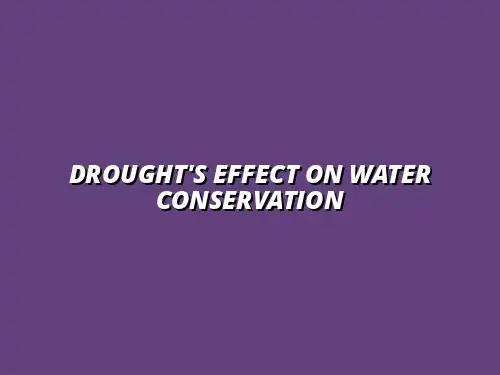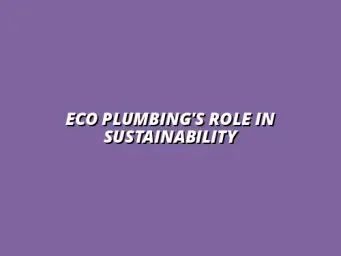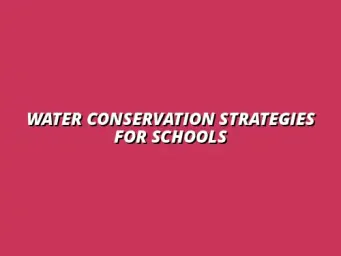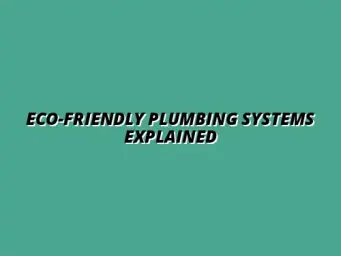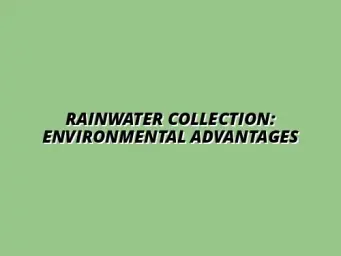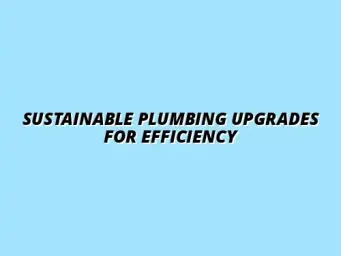The Relationship Between Drought and Water Conservation Strategies
Understanding Drought: Causes and Effects
Defining Drought in Various Contexts
When we talk about drought, it can mean different things depending on where you are or who you ask. Generally, drought refers to a prolonged period of below-average precipitation, leading to water shortages. This definition can vary based on regions, agriculture, or even local water needs, making it vital to understand these different contexts.
In agricultural terms, drought may mean crop failures due to insufficient rain. For urban areas, it could involve limited water supply for households. Realizing these definitions helps communities better prepare for and respond to drought situations.
Key Factors Contributing to Drought Conditions
Several factors can lead to drought conditions, including both natural events and human activities. Some of the most significant factors include:
- Climate change, leading to altered weather patterns
- Deforestation, which impacts local rainfall
- Overconsumption of water resources, stressing available supplies
Understanding these factors is crucial. It allows communities to take proactive measures to mitigate the impacts of drought and improve their water management practices.
Impacts of Drought on Ecosystems and Communities
Drought has serious consequences for both ecosystems and local communities. Wildlife habitats can suffer, leading to decreased biodiversity. Plants that rely on consistent moisture may die off, which can change the landscape dramatically.
Communities, particularly those dependent on agriculture, can face economic hardship. Water shortages can affect everything from crop yields to daily life, emphasizing the need for effective water conservation strategies during dry spells. For practical tips on saving water at home, check out these water-saving tips.
The Necessity of Water Conservation Strategies in Drought Conditions
Assessing the Role of Water Conservation during Drought
In times of drought, it becomes essential to focus on water conservation strategies. These strategies help ensure that limited water resources are used efficiently. They play a critical role in managing what little water is available, especially for agriculture and households.
Conservation strategies can greatly reduce the impacts of drought. When people understand the importance of saving water, they can make a significant difference in their communities.
How Drought Influences Water Management Policies
Drought conditions significantly influence how water management policies are shaped. Policymakers often have to make tough decisions based on available data and projected water use. Some common changes in policy during drought include:
- Implementing water restrictions for households and businesses
- Encouraging the use of drought-resistant crops in agriculture
- Investing in infrastructure for water recycling and conservation
These adaptations help mitigate the risks associated with drought and ensure communities have the resources they need to survive.
Types of Water Conservation Strategies
Various water conservation strategies can be implemented in response to drought conditions. Some effective methods include:
- Rainwater harvesting systems
- Drip irrigation for agriculture
- Public education campaigns about water-saving practices
Each of these strategies addresses the water crisis from different angles. By combining various approaches, communities can enhance their resilience against drought. Learn how to reduce water waste with daily tips for significant savings.
Adapting Water Conservation Techniques in Response to Drought
Innovative Technologies for Efficient Water Use
Technology plays a vital role in improving water conservation efforts. New tools and systems can help us use water more wisely, especially during droughts. Some innovative technologies include:
- Smart irrigation systems that adjust automatically
- Water monitoring apps for households and businesses
- Desalination technology for converting seawater into drinking water
These advancements not only save water but also empower communities to actively manage their resources. Addressing sudden water pressure drops can also play a significant role; find out how to fix them here.
Behavioral Changes and Community Engagement in Water Conservation
Another crucial aspect of drought response is fostering behavioral changes within communities. Encouraging people to adopt water-saving habits can lead to significant savings. Strategies that involve community engagement include:
- Workshops on water-efficient gardening
- Community challenges to reduce water usage
- Incentives for installing water-saving appliances
By working together, communities can create a culture of conservation that can withstand drought. Saving water while washing dishes is another key area; discover helpful tips and tricks here.
Case Studies: Successful Drought Response Initiatives
Many places have successfully implemented drought response initiatives that serve as great examples. Some notable case studies include:
- California’s water conservation campaigns during drought periods
- Australia’s water recycling programs after severe droughts
- Israel’s advanced irrigation technologies in agriculture
These initiatives demonstrate the effectiveness of strategic planning and community involvement in overcoming drought challenges.
Challenges and Limitations of Water Conservation During Drought
Economic Factors Affecting Water Conservation Efforts
Despite the need for effective water conservation strategies, several economic factors can hinder progress. For example, the cost of implementing new technology or infrastructure can be a significant barrier. Many communities struggle to find funding for such projects, which can limit their ability to respond to drought effectively.
Additionally, water pricing can also impact conservation efforts. If water is too cheap, people may have less incentive to conserve it during dry periods. Proper maintenance of your water heater can also greatly impact water usage. Learn more about seasonal water heater care.
Political and Regulatory Hurdles in Implementing Strategies
Political and regulatory challenges can also complicate water conservation strategies. Different levels of government may have conflicting interests, making it hard to implement cohesive plans. Some common hurdles include:
- Inconsistent regulations across regions
- Lobbying by industries that rely heavily on water
- Public resistance to policy changes
Addressing these challenges requires collaboration and a shared vision for sustainable water use. Preventing mold in bathroom pipes is also crucial for maintaining water efficiency and preventing costly repairs. See how to prevent mold.
Environmental Trade-offs and Conservation Decisions
Finally, while pursuing water conservation strategies, we must consider potential environmental trade-offs. Some methods may have unintended consequences, such as:
- Impacting local wildlife habitats
- Changing the natural water cycle
- Causing soil degradation over time
Being aware of these trade-offs can help communities make informed decisions and find a balance between conservation and environmental health. For plumbing services in Lozells, Birmingham, consider contacting a local plumber.
Addressing Common Questions About Drought and Water Conservation
When it comes to drought and water conservation, many people have questions about the best methods to save water. Understanding these methods is crucial, especially during severe drought conditions. Let’s dive into some of the most common inquiries regarding effective water conservation strategies!
What are the Most Effective Water Conservation Methods During Drought?
Water conservation methods can vary widely, but they generally fall into two categories: traditional and modern techniques. Traditional methods often include practices that have been passed down through generations, while modern techniques incorporate technology and innovation. Both approaches can play a vital role in managing water resources during a drought.
Analyzing Traditional vs. Modern Conservation Techniques
Traditional water conservation methods focus on simple practices that have proven effective over time. Here are some examples:
- Rainwater harvesting: Collecting and storing rainwater for later use.
- Mulching: Covering soil with organic material to retain moisture.
- Crop rotation: Changing the type of crops grown to improve soil health and water retention.
On the other hand, modern conservation techniques are increasingly reliant on technology. Some popular modern methods include:
- Smart irrigation systems: Using sensors to optimize water usage for plants.
- Water-efficient appliances: Installing low-flow fixtures and devices that reduce water consumption.
- Leak detection technology: Identifying and fixing leaks in water supply systems.
Community Initiatives and Their Impact on Water Conservation
Communities play a crucial role in implementing water conservation strategies. By coming together, they can greatly amplify their efforts. Community initiatives can include:
- Organizing neighborhood clean-up and conservation events.
- Creating local awareness campaigns about drought conditions.
- Setting up community gardens that utilize water-efficient practices.
These initiatives not only educate residents but also foster a sense of shared responsibility in taking care of our water resources.
How Can Individuals Contribute to Water Conservation Efforts?
While community efforts are important, individual actions also play a significant role in water conservation. Each person can contribute in their own way! Here are some practical tips that households can use to save water effectively.
Practical Tips for Households to Save Water
Every little bit counts! Here are some simple, yet effective, ways for individuals and families to conserve water:
- Turn off the tap while brushing teeth or shaving.
- Take shorter showers to minimize water use.
- Use a broom instead of a hose to clean driveways and sidewalks.
- Fix any leaks in faucets and toilets promptly.
- Collect and reuse greywater for gardening.
By adopting even a few of these practices, individuals can make a noticeable difference in overall water consumption.
Engaging the Community in Sustainable Practices
Engagement is key when it comes to driving water conservation efforts. Here are some ways to inspire community participation:
- Host workshops to educate others about saving water.
- Establish neighborhood challenges focused on reducing water use.
- Collaborate with local schools to teach students about water conservation.
Encouraging dialogue and sharing success stories can motivate others to join the cause!
The Future of Water Conservation Strategies in Drought-Prone Areas
As we look ahead, the challenge of conserving water in drought-prone areas remains critical. Innovative strategies and policies are necessary to ensure sustainable water use for future generations.
Emerging Trends in Water Use Efficiency
New technologies and practices are emerging to improve water efficiency dramatically. Some noteworthy trends include:
- Utilization of artificial intelligence (AI) to optimize irrigation systems.
- Expansion of drought-resistant crops to minimize water dependency.
- Development of wastewater treatment methods that allow for safe reuse.
These advancements not only help manage existing resources better but also serve as a foundation for future conservation efforts.
The Role of Policy and Education in Shaping Future Strategies
Effective water conservation requires strong policies and education. It's essential to:
- Implement regulations that promote sustainable water use.
- Educate the public about the importance of water conservation.
- Encourage partnerships between government, businesses, and communities.
Such efforts can help instill a culture of water conservation that lasts for generations!
Key Takeaways on the Impact of Drought on Water Conservation Strategies
In summary, adapting our water conservation strategies in response to drought is critical. By understanding the methods available and engaging both individuals and communities, we can make a significant impact!
Summarizing the Importance of Adaptive Water Management
It’s essential to proactively manage water resources, especially in drought-prone areas. Recognizing the value of efficient water use will help us prepare for future challenges.
Encouraging Proactive Measures for Future Droughts
Taking steps now to conserve water can have lasting effects on our environment. I encourage everyone to consider how they can contribute and think about the ways we can collectively safeguard our water resources.
Inviting Engagement and Action from Readers
Water conservation is a shared responsibility. I invite you to join in the conversation and take action in your own community. Together, let’s make a real difference in how we manage and use water!

